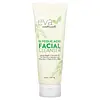What's inside
What's inside
 Key Ingredients
Key Ingredients

 Benefits
Benefits

 Concerns
Concerns

 Ingredients Side-by-side
Ingredients Side-by-side

Water
Skin ConditioningAloe Barbadensis Leaf Juice
Skin ConditioningDimethyl Sulfone
SolventJojoba Esters
EmollientDecyl Glucoside
CleansingCocamidopropyl Betaine
CleansingCocamidopropyl Hydroxysultaine
CleansingPhenoxyethanol
PreservativeCocamide Mipa
EmulsifyingCarrageenan
Cucumis Sativus Extract
Skin ConditioningDisodium Laureth Sulfosuccinate
CleansingDisodium Lauryl Sulfosuccinate
CleansingAcrylates/C10-30 Alkyl Acrylate Crosspolymer
Emulsion StabilisingLavandula Angustifolia Water
MaskingSodium Hydroxide
BufferingGanoderma Lucidum Extract
Skin ProtectingEthylhexylglycerin
Skin ConditioningGlycolic Acid
BufferingArctium Lappa Root Extract
Skin ConditioningCalendula Officinalis Extract
Skin ConditioningCitrus Grandis Seed Extract
AstringentRosmarinus Officinalis Extract
AntimicrobialSalix Alba Bark Extract
AstringentSimmondsia Chinensis Seed Oil
EmollientTrifolium Pratense Leaf Extract
AntioxidantOlea Europaea Fruit Oil
MaskingPotassium Sorbate
PreservativeSodium Benzoate
MaskingAlcohol
AntimicrobialCentella Asiatica Extract
CleansingEquisetum Arvense Extract
AstringentGeranium Maculatum Extract
TonicTaraxacum Officinale Extract
Skin ConditioningBorago Officinalis Seed Oil
EmollientRosa Canina Fruit Oil
EmollientCitrus Aurantium Dulcis Peel Extract
Emulsion StabilisingOriganum Vulgare Extract
Skin ConditioningTocopheryl Acetate
AntioxidantWater, Aloe Barbadensis Leaf Juice, Dimethyl Sulfone, Jojoba Esters, Decyl Glucoside, Cocamidopropyl Betaine, Cocamidopropyl Hydroxysultaine, Phenoxyethanol, Cocamide Mipa, Carrageenan, Cucumis Sativus Extract, Disodium Laureth Sulfosuccinate, Disodium Lauryl Sulfosuccinate, Acrylates/C10-30 Alkyl Acrylate Crosspolymer, Lavandula Angustifolia Water, Sodium Hydroxide, Ganoderma Lucidum Extract, Ethylhexylglycerin, Glycolic Acid, Arctium Lappa Root Extract, Calendula Officinalis Extract, Citrus Grandis Seed Extract, Rosmarinus Officinalis Extract, Salix Alba Bark Extract, Simmondsia Chinensis Seed Oil, Trifolium Pratense Leaf Extract, Olea Europaea Fruit Oil, Potassium Sorbate, Sodium Benzoate, Alcohol, Centella Asiatica Extract, Equisetum Arvense Extract, Geranium Maculatum Extract, Taraxacum Officinale Extract, Borago Officinalis Seed Oil, Rosa Canina Fruit Oil, Citrus Aurantium Dulcis Peel Extract, Origanum Vulgare Extract, Tocopheryl Acetate
Water
Skin ConditioningSodium Lauroyl Sarcosinate
CleansingCocamidopropyl Betaine
CleansingSodium Lauroamphoacetate
CleansingNiacinamide
SmoothingSalicylic Acid
MaskingDecyl Glucoside
CleansingGlycerin
HumectantSodium Chloride
MaskingCeramide NP
Skin ConditioningCeramide Ng
Skin ConditioningCeramide As
Skin ConditioningCeramide EOP
Skin ConditioningCeramide AP
Skin ConditioningSodium Lauroyl Oat Amino Acids
CleansingSodium Hyaluronate
HumectantTocopherol
AntioxidantGlycosyl Trehalose
Emulsion StabilisingHydrogenated Lecithin
EmulsifyingPropylene Glycol Laurate
Skin ConditioningPEG-120 Methyl Glucose Dioleate
EmulsifyingCitric Acid
BufferingPhenoxyethanol
PreservativeHydroxyacetophenone
AntioxidantHydrogenated Starch Hydrolysate
HumectantChlorphenesin
AntimicrobialDextrin
AbsorbentDisodium EDTA
Sodium Benzoate
MaskingEthylhexylglycerin
Skin ConditioningTetrasodium EDTA
Water, Sodium Lauroyl Sarcosinate, Cocamidopropyl Betaine, Sodium Lauroamphoacetate, Niacinamide, Salicylic Acid, Decyl Glucoside, Glycerin, Sodium Chloride, Ceramide NP, Ceramide Ng, Ceramide As, Ceramide EOP, Ceramide AP, Sodium Lauroyl Oat Amino Acids, Sodium Hyaluronate, Tocopherol, Glycosyl Trehalose, Hydrogenated Lecithin, Propylene Glycol Laurate, PEG-120 Methyl Glucose Dioleate, Citric Acid, Phenoxyethanol, Hydroxyacetophenone, Hydrogenated Starch Hydrolysate, Chlorphenesin, Dextrin, Disodium EDTA, Sodium Benzoate, Ethylhexylglycerin, Tetrasodium EDTA
 Reviews
Reviews

Ingredients Explained
These ingredients are found in both products.
Ingredients higher up in an ingredient list are typically present in a larger amount.
Cocamidopropyl Betaine is a fatty acid created by mixing similar compounds in coconut oil and dimethylaminopropylamine, a compound with two amino groups.
This ingredient is a surfactant and cleanser. It helps gather the dirt, pollutants, and other impurities in your skin to be washed away. It also helps thicken a product and make the texture more creamy.
Being created from coconut oil means Cocamidopropyl Betaine is hydrating for the skin.
While Cocamidopropyl Betaine was believed to be an allergen, a study from 2012 disproved this. It found two compounds in unpure Cocamidopropyl Betaine to be the irritants: aminoamide and 3-dimethylaminopropylamine. High-grade and pure Cocamidopropyl Betaine did not induce allergic reactions during this study.
Learn more about Cocamidopropyl BetaineDecyl Glucoside is a glucose-based surfactant and emulsion stabilizer. It is created by reacting glucose with the fatty acids from plants.
Surfactants help clean the skin by trapping oil, sebum, and dirt to be washed away. As an emulsion stabilizer, it stabilizes the ingredients in a product by preventing them from separating.
This ingredient is biodegradable and non-toxic. This ingredient is commonly found in baby shampoos.
Decyl Glucoside is sometimes used to stabilize the UV filter Tinosorb.
Learn more about Decyl GlucosideEthylhexylglycerin (we can't pronounce this either) is commonly used as a preservative and skin softener. It is derived from glyceryl.
You might see Ethylhexylglycerin often paired with other preservatives such as phenoxyethanol. Ethylhexylglycerin has been found to increase the effectiveness of these other preservatives.
Phenoxyethanol is a preservative that has germicide, antimicrobial, and aromatic properties. Studies show that phenoxyethanol can prevent microbial growth. By itself, it has a scent that is similar to that of a rose.
It's often used in formulations along with Caprylyl Glycol to preserve the shelf life of products.
Sodium Benzoate is a preservative. It's used in both cosmetic and food products to inhibit the growth of mold and bacteria. It is typically produced synthetically.
Both the US FDA and EU Health Committee have approved the use of sodium benzoate. In the US, levels of 0.1% (of the total product) are allowed.
Sodium benzoate works as a preservative by inhibiting the growth of bacteria inside of cells. It prevents the cell from fermenting a type of sugar using an enzyme called phosphofructokinase.
It is the salt of benzoic acid. Foods containing sodium benzoate include soda, salad dressings, condiments, fruit juices, wines, and snack foods.
Studies for using ascorbic acid and sodium benzoate in cosmetics are lacking, especially in skincare routines with multiple steps.
We always recommend speaking with a professional, such as a dermatologist, if you have any concerns.
Learn more about Sodium BenzoateWater. It's the most common cosmetic ingredient of all. You'll usually see it at the top of ingredient lists, meaning that it makes up the largest part of the product.
So why is it so popular? Water most often acts as a solvent - this means that it helps dissolve other ingredients into the formulation.
You'll also recognize water as that liquid we all need to stay alive. If you see this, drink a glass of water. Stay hydrated!
Learn more about Water